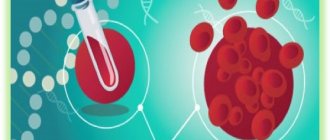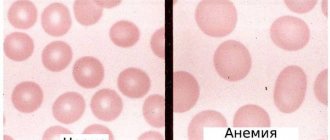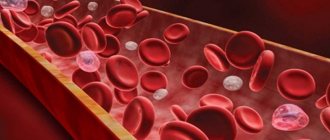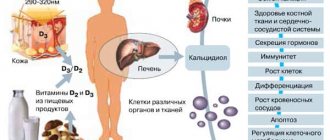| The problem of low hemoglobin is familiar to many pregnant women. But not everyone knows what consequences this problem can have, what it is fraught with, and do not take the doctor’s words seriously. This article will help you learn about the dangers of low hemoglobin levels in those who are pregnant. You will also learn about proper treatment. |
- What is low hemoglobin?
- Classification and causes of anemia
- Causes of low hemoglobin in pregnant women
- Symptoms
- Degrees
- Consequences of low hemoglobin levels
- Treatment
- Prevention
Classification and causes of anemia
- iron deficiency
It becomes a consequence of a drop in iron levels in the blood. The main reasons are constant bleeding (from the uterus, with hemorrhoids, with a duodenal ulcer, with an advanced stomach ulcer) and bearing a child.
- hemolytic
The reasons may be:
- exposure to cold
- genetic diseases
- poisoning of the body with heavy metals
- poisoning by poisons
- B12 deficiency anemia
Causes:
- parasitic infectious diseases
- impaired absorption of vitamin B12 in the small intestine
- unhealthy diet (a person eats foods that contain almost no vitamin B12)
- gestational (anemia of pregnant women)
Mostly, those who are carrying a child are diagnosed with anemia, which occurs when there is a lack of iron in the body.
- posthemorrhagic
It becomes a consequence of blood loss, and the reasons can be very different.
Causes of low hemoglobin in pregnant women
The following factors provoke a decrease in hemoglobin in pregnant women:
- increase in blood volume
The formation of the circulatory system of the embryo occurs, which during the gestational period is connected with the vessels of the expectant mother. The fetus has organs that produce blood. Therefore, as soon as the fetus develops, the blood volume gradually increases. Therefore, its amount becomes greater, but the amount of hemoglobin may not increase. This is typical for the twentieth and later weeks of gestation.
- needs of the future baby
As the embryo develops, it needs vitamins and other useful substances. He also needs iron. There is less iron in the blood, which is why a decrease in hemoglobin is recorded in a pregnant woman.
- multiple pregnancy
A multiple pregnancy is a pregnancy in which the mother is expecting two, three, four or more children. Since there are many children, they also need a lot of iron. If a pregnant woman’s body is low in zinc and copper, anemia may develop, and this is a dangerous condition.
- pregnancy soon after birth
It’s not for nothing that doctors say that you can’t give birth to children one after the other. Mom's body needs to recover. If very little time has passed since the previous birth (up to 3 years), then iron reserves are not restored. And the baby’s body takes this element from the mother, resulting in anemia.
- medication treatment
Some medications affect the absorption of iron and the amount of it in the mother's blood. Therefore, you need to be attentive to yourself, consult with a gynecologist about medications that you take a year or less before conception, as well as during pregnancy. Also remember that drug treatment in the first trimester almost always has a very negative effect on the condition of the embryo.
- bleeding associated with pregnancy pathologies
If a woman has lost a large amount of blood due to retrochorial hematoma, detachment of the ovum, placental abruption, or miscarriage, the result may be anemia. Experienced doctors prevent this condition in pregnant women.
- intestinal dysbiosis
Iron supplied with foods and dietary supplements is simply not fully absorbed into the gastrointestinal tract.
- changes in hormonal balance
The amount of estrogen hormones in the body increases after conception, which is necessary for normal childbearing. Therefore, iron is less absorbed in a woman’s intestines.
- nervous tension and constant stress
This factor can provoke not only low hemoglobin during pregnancy, but also other dangerous pathologies of the mother and unborn baby. Try to protect yourself as much as possible from worries, stressful work and communication with unpleasant individuals.
- exacerbation of chronic pathologies
Iron is consumed more if the pregnant woman begins to actively show symptoms of a chronic disease.
- toxicosis
In the first trimester, most women suffer from toxicosis. This condition includes nausea and vomiting. When vomiting, the absorption of iron and other useful substances becomes several times less, which ultimately leads to a decrease in hemoglobin.
In pregnant women, the lowest hemoglobin level is observed at the thirty-second or thirty-third week of gestation. And by the time of birth, hemoglobin increases, even if no measures are taken. In the first trimester, the mother's body needs as much iron as before pregnancy. Therefore, you do not need to take any medications, especially by your own decision. In the second trimester, the need increases by 2 times compared to the non-essential period. In the last trimester, iron requirements are five times higher.
The statistics of cases of anemia in pregnant women after the twentieth week of gestation is 10-20 times higher than the incidence statistics in the first trimester.
Necessary tests
All pregnant women must have their fasting venous blood plasma glucose tested in a laboratory (cannot be tested using portable glucose self-monitoring devices - glucometers!) - against the background of a normal diet and physical activity - upon first contact with the antenatal clinic or perinatal center (as possible earlier!), but no later than 24 weeks of pregnancy. It should be remembered that during pregnancy the blood glucose level on an empty stomach is lower, and after eating it is higher than outside pregnancy!
Pregnant women whose blood glucose levels, according to WHO recommendations, meet the diagnostic criteria for diabetes mellitus or impaired glucose tolerance are diagnosed with gestational diabetes mellitus. If the results of the study correspond to normal indicators during pregnancy, then an oral glucose tolerance test - OGTT ("stress test" with 75 g of glucose) is mandatory at 24-28 weeks of pregnancy in order to actively identify possible disorders of carbohydrate metabolism. All over the world, OGTT with 75 g of glucose is a safe and the only diagnostic test for detecting disorders of carbohydrate metabolism during pregnancy!
| Research time | Venous plasma glucose | ||
| On an empty stomach | > 7.0 mmol/l (> 126 mg/dl) | > 5.1 < 7.0 mmol/l (>92<126 mg/dl) | <5.1 mmol/L (<92 mg/dL) |
| At any time of the day if there are symptoms of hyperglycemia (dry mouth, thirst, increased volume of urine excreted per day, itching, etc.) | > 11.1 mmol/l | — | — |
| Glycated hemoglobin (HbA1C) | > 6,5% | — | — |
| OGTT with 75 g anhydrous glucose h/w 1 hour after meals | — | >10 mmol/l (>180 mg/dl) | < 10 mmol/l (<180 mg/dl) |
| OGTT with 75 g anhydrous glucose h/w 2 hours after meals | — | > 8.5 mmol/l (> 153 mg/dl) | <8.5 mmol/l (<153 mg/dl) |
| Diagnosis | diabetes mellitus type 1 or 2 during pregnancy | Gestational diabetes mellitus | Physiological blood glucose levels during pregnancy |
Remember that normalizing carbohydrate metabolism in a pregnant woman allows you to avoid complications from both the course of pregnancy itself and the condition of the fetus!
After a diagnosis of gestational diabetes mellitus is made, all women require constant monitoring by an endocrinologist together with an obstetrician-gynecologist. Pregnant women should be trained in the principles of rational nutrition, self-control and behavior in conditions of a new pathological condition (i.e., timely testing and visits to specialists - at least once every 2 weeks).
A pregnant woman's diet should be sufficiently high in calories and balanced in basic food ingredients to provide the developing fetus with all the necessary nutrients. At the same time, in women with gestational diabetes mellitus, taking into account the characteristics of the pathological condition, nutrition should be adjusted. The basic principles of diet therapy include ensuring stable normoglycemia (maintaining blood glucose levels corresponding to those for physiological pregnancy), and preventing ketonemia (the appearance of fat breakdown products - “hungry” ketones - in the urine), as mentioned above in the text.
Increased postprandial blood glucose levels (above 6.7 mmol/L) are associated with an increased incidence of fetal macrosomia. Therefore, a pregnant woman should exclude easily digestible carbohydrates from food (which lead to a rapid uncontrollable rise in blood glucose) and give preference in the diet to difficult-to-digest carbohydrates high in dietary fiber - carbohydrates protected by dietary fiber (for example, many vegetables, legumes) have a low glycemic index. The glycemic index (GI) is a factor in the rate of absorption of carbohydrates.
Symptoms
An asymptomatic course is typical for low hemoglobin during pregnancy. Basically, symptoms make themselves felt immediately after the level of iron in the blood begins to fall. Common symptoms include:
- pale skin
- dizziness
- fatigue
- low performance
- weakness in the body
- shortness of breath even with minimal physical activity
- fainting
- brittle nails
- increase in heart rate
- severe hair loss on the scalp
- sores and cracks in the corners of the mouth
- desire to eat unusual or unintended foods
- desire to smell something that is unpleasant for ordinary people
A pregnant woman may have 1-2 symptoms listed in this list, but in such cases there is no need to immediately diagnose yourself with anemia. A couple of symptoms may also indicate completely different conditions, including toxicosis of the first trimester and its consequences. Therefore, it is important to consult a doctor so that he can prescribe tests and conduct the necessary studies to make a clear diagnosis.
Predictions and prevention
Since a high level of iron-containing protein in pregnant women is a concomitant condition, all complications develop as a consequence of the underlying disease. Therefore, prevention of exceeding the permissible norm of the hemoglobin indicator is nonspecific. It is enough for a woman to monitor her well-being, switch to proper nutrition, give up bad habits and be physically active. Following these simple recommendations greatly reduces the likelihood of worsening the pathology.
With elevated levels of iron-containing protein, the prognosis is usually favorable. Drug therapy is not required if there are no obvious symptoms. To bring the hemoglobin indicator back to normal, it is enough to eliminate blood viscosity and the tendency to form blood clots and rehydrate the body. Treatment consists of following a special diet and using folk remedies.
Pregnant women rarely develop high hemoglobin. Normalizing its level involves following a special diet and adjusting your lifestyle. Drug therapy to correct iron-containing protein in pregnant women is rarely used and only in case of significant excess of the norm.
Degrees
There are three degrees of drop in hemoglobin levels in women expecting a child:
- first (per 1 liter of blood 90-110 g of hemoglobin; mostly occurs hidden)
- second (the degree is considered average, 70-90 grams of hemoglobin are detected per 1 liter of blood; here the symptoms are more likely, but they are not alarming, so the woman may not contact a gynecologist in time)
- third (in the blood there is less than 70 grams of hemoglobin per liter, a lot of symptoms appear)
The third degree is considered severe, and there may be irreversible consequences for the unborn baby and his mother.
Consequences of low hemoglobin levels
- gestosis
The pregnant woman develops edema, her blood pressure rises, and protein is found in the urine when the appropriate analysis is performed. The liver cannot function normally, less protein is produced than the body needs, and water metabolism is significantly disrupted. If the course of gestosis is severe, the pregnant woman’s brain will lack oxygen, followed by headaches. Sometimes preeclampsia is diagnosed, and in the absence of therapeutic measures taken, eclampsia. In the latter case, the pregnancy is terminated for medical reasons.
- embryonic development delay
If there is not enough oxygen in the mother’s body, then the child also lacks it. Its development becomes slow, and first of all, a very important organ, the brain, suffers.
- risk of premature birth
Low hemoglobin during pregnancy can lead to early placental abruption. If medical assistance is not quickly provided, the fetus may die, and there is also a risk of death of the mother. If the third degree of anemia is observed, then in 12 cases out of 100 the child is born dead.
- risk of infectious diseases after childbirth
- bleeding during childbirth or weakness of labor
- lactation disorders
Among the long-term consequences, as scientists from the United States write, is senile dementia. The study, which was conducted over eleven years, showed that with low hemoglobin levels, the risk of dementia in the elderly increases by 41%. The reason is that oxygen starvation leads to the death of neurons.
Child health problems with gestational diabetes mellitus
Thus, at the birth of children with fetopathy, there is a violation of their adaptation to extrauterine life, which is manifested by the immaturity of the newborn even with a full-term pregnancy and its large size: macrosomia (child weight more than 4000 g), respiratory disorders up to asphyxia (suffocation), organomegaly (enlarged spleen, liver, heart, pancreas), heart pathology (primary damage to the heart muscle), obesity, jaundice, disorders in the blood coagulation system, the content of erythrocytes (red blood cells) in the blood increases, as well as metabolic disorders (low values of glucose, calcium , potassium, magnesium blood).
Children born to mothers with uncompensated gestational diabetes mellitus are more likely to experience neurological diseases (cerebral palsy, epilepsy); during puberty and thereafter, the risk of developing obesity, metabolic disorders (in particular, carbohydrate metabolism), and cardiovascular diseases is increased.
On the part of a pregnant woman with gestational diabetes mellitus, polyhydramnios, early toxicosis, urinary tract infections, and late toxicosis are more common (a pathological condition that is manifested by the appearance of edema, high blood pressure and proteinuria (protein in the urine), develops in the second and third trimester up to preeclampsia - cerebrovascular accident, which can lead to cerebral edema, increased intracranial pressure, functional disorders of the nervous system), premature birth, spontaneous abortion, delivery by cesarean section, labor anomalies, and trauma during childbirth are more common.
Disorders of carbohydrate metabolism can develop in any pregnant woman, taking into account the hormonal and metabolic changes that consistently occur at different stages of pregnancy. But the highest risk of developing gestational diabetes is in women who are overweight/obese and over 25 years of age; presence of diabetes in close relatives; with disorders of carbohydrate metabolism identified before the current pregnancy (impaired glucose tolerance, impaired fasting glycemia, gestational diabetes in previous pregnancies); glucosuria during pregnancy (the appearance of glucose in the urine).
Gestational diabetes mellitus, which first developed during pregnancy, often does not have clinical manifestations associated with hyperglycemia (dry mouth, thirst, increased volume of urine excreted per day, itching, etc.) and requires active detection (screening) during pregnancy !
Treatment
It is important to pay attention to nutrition, but this does not replace taking medications prescribed by your doctor. A pregnant woman in the second trimester needs 3 or 4 mg of iron per day. In the last 3 months of gestation, the need is greater; as already noted, it is approximately 10 mg. Diet to treat low hemoglobin in a pregnant woman is not enough. A day, eating right, you can get only 1 mg of iron with food, and this is too little.
If little iron is supplied with food, then the body will initially use what is stored in the depot “in reserve.” But by the twentieth week, in such a situation, it is already possible to receive a diagnosis of anemia.
There are 2 types of iron : heme and non-heme. The latter type is found in our food, but it is not reflected in the level of hemoglobin in the blood. This is another fact in favor of refuting the myth about adjusting hemoglobin levels during pregnancy with a balanced diet. Yes, eating right is important, but in the case of anemia, it is only one step towards recovery.
Leading products in iron content:
- liver
- meat
- eggs
- fish
- spinach
- apricot
- pomegranate
- oatmeal
- beet
- peaches
The human body absorbs about 6% of iron from animal products, and 0.2% of the total iron it contains from plant products.
Treatment with drugs
To adjust hemoglobin levels, it is important to take medications with heme iron. Its absorption occurs at a higher level, so there is more hemoglobin in the blood in a short time. The drugs must be prescribed on a case-by-case basis by the attending physician. The dosage may vary for all pregnant women.
Drugs for the treatment of anemia:
- Maltofer
- Tardiferon
- Sorbifer
- Totema
- Ferrum Lek
When prescribing, the doctor takes into account the degree of anemia the patient has and whether she has intolerance to the drug.
Diagnostics
As a rule, a pregnant woman does not feel at all that her level of iron-containing protein is increased. The deviation is detected by chance after a regular blood test or during a sudden deterioration in health. During the next visit to the gynecologist, the specialist examines the woman to exclude the possibility of developing varicose veins.
A blood test is done to determine hemoglobin protein levels. In addition to the general study, a coagulogram is performed, which determines the level of coagulation. During the general examination, the content of hemoglobin protein, ESR indicators, the level of erythrocytes and leukocytes are noted. In a healthy woman, iron-containing protein ranges from 120 to 140 g/l. If the increase in level does not exceed 10%, they speak of physiological thickening. When hemoglobin protein rises above 160 g/l, treatment is necessary.
Important! Additionally, a general laboratory examination of urine analysis is carried out. This is necessary to eliminate the risk of kidney infection. If a pronounced density of blood flow is detected, instrumental diagnostics are performed. It is needed to determine how severely the venous and cardiac circulation is impaired.
To determine the speed of blood flow in the internal organs, some patients undergo duplex ultrasound examination. Exceeding the standard value indicates an increased content of iron-binding protein. If necessary, additional venography is performed. This study shows the condition of the veins and allows you to evaluate prognoses. For phlebography, contrast components are injected into the vessels.










